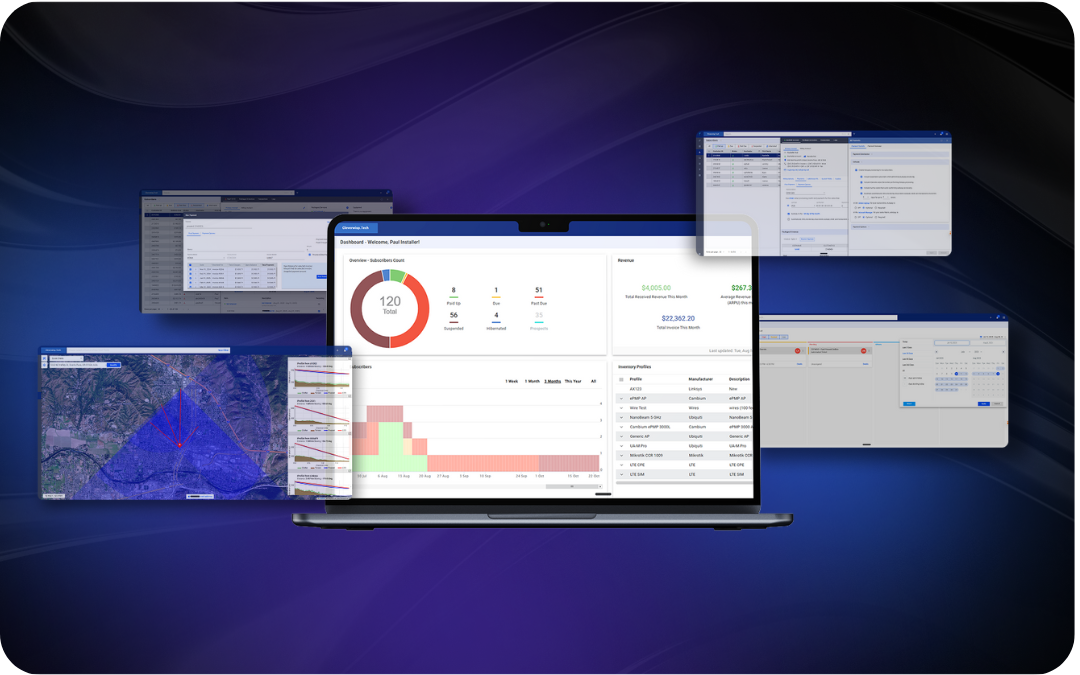If you are dizzy just trying to keep up with federal broadband grants in 2021 – join the club. The playing field shifts with frequency, making it a challenge to keep up. Here’s what’s happening as of this writing:
The Biden Administration’s original $3.5 trillion infrastructure plan earmarks $100 billion for rapid internet expansion. (1) This plan prioritizes networks owned by government-owned networks (GON), including cities, Tribal governments and nonprofits. In addition, it contains proposed minimum internet requirements that put grants out of reach for wireless providers, specifically 100 Mbps down X 100 Mbps up.
In August 2021, a bipartisan bill was passed with $65 billion in funds for internet expansion. (2) The grants will be given to states and, according to WISPA, the requirements are less restrictive than the original infrastructure plan, making WISPs eligible for this grant money. (3)
However, the Senate will still consider the larger $3.5 trillion package and Speaker Nancy Pelosi says the House will eventually examine both of the bills together at a later date.
An attendee of the Texas WISP Meetup said that a WISPA lobbyist reported that Congress will likely debate the original plan through 2021 and eventually pass it as is or with revisions before the holiday break to show movement on some measures.
WISPA continues to lobby to adjust the 100 Mbps X100 Mbps requirement to 100 X 20 so WISPs can be eligible for money from broadband grants.
The likelihood of your WISP receiving federal grants depends on which version of the bill will pass. How can you prepare for an uncertain path? This article discusses the more restrictive requirements in the larger infrastructure bill and how WISPs can benefit.
Broadband Grants in the Original Infrastructure Plan
The original proposal prioritized GONs, to:
- Keep broadband costs low
- Improve internet accessibility
- Ensure expanding quality service is the driving factor rather than profit
The logic of this move could be to avoid repeats of past failures. Despite allocating $47.3 billion to close the internet gap between 2009 and 2017, 42 million Americans were without access to high-speed internet in 2020, according to BroadbandNow.
While the concept of Muni-WISPs sounds straightforward, it’s not. There are currently GON restrictions in 18 states that restrict municipalities from owning ISPs in 2021: (4)
- Alabama
- Florida
- Louisiana
- Minnesota
- Missouri
- Montana
- Michigan
- Nebraska
- Nevada
- North Carolina
- Pennsylvania
- South Carolina
- Tennessee
- Texas
- Utah
- Virginia
- *Washington
- Wisconsin
While there have been initiatives to block GONs, five states in 2021 have passed laws that support municipal networks including *Washington. This may indicate growing support for Muni-ISPs.

Four young men plan out their federal grant application
Is it worth it for WISPs to pursue federal grant funding?
The short answer is, “Yes.” If expansion is part of your business plan and the funds are for big-ticket projects, like fiber build-out, the addition of grant funding brings plans to fruition faster.
Not convinced? Consider the worst-case scenario – a competitor secures government funding and your ISP is left out in the cold. The competitor can encroach on your territory and overgrow the area. If this happens, it may be impossible for you to remain competitive.
Broadband grant plan criticisms
The current proposal isn’t a guarantee and there could be adjustments made before it’s approved. The most frequent criticism is the absence of real-world provider experience in the plan.
Most municipalities and government agencies are not in the position to build an ISP from the ground up. If munis are prioritized, WISPs can position themselves as experts and partner with a local government entity to create grant applications that meet the federal funding requirements.
Some legislators want to restrict GONs presumably to keep WISPs independent. Yet, a compromise to include Muni-WISPs in grant funding can work. Read on.
Muni-ISP Relationship Success
There’s no need to be concerned about the acceptance and likelihood of success, Muni-ISPs are already a winning concept embraced by the federal government.
The US Department of Commerce Telecommunications and Information division announced a new $288 million grant for partnerships between ISPs/fixed wireless providers and state government entities on May 19, 2021. (5)
The grant’s goals are similar to the infrastructure plan, to expand quality, affordable internet to rural regions. Happily, its broadband minimums are 100 Mbps down and 20 Mbps up.
And, you don’t have to look far for successful examples of Municipal GONs, there are about 600 operating in the U.S. as of 2021. (6) Here’s one example of how ISPs can work with a GON.
Ammon, Idaho
According to a 2019 Fast Company article, Ammon, Idaho is the American city with the most sophisticated internet setup. (7) The city began building its network in 2011 by contacting a local telephone company to help them set up its fiber infrastructure.
By 2019, Ammon had created an open network with municipal fiber, allowing the eight local providers to use their infrastructure to provide their services to individuals and businesses in the city. There are many benefits, including affordability, reliability and choice of provider ending the possibilities of a monopoly of large telcos or cable companies.
A New Reality
With the success of GONs and the likelihood that some government funds will go to municipalities, independent WISPs have decisions to make. They can decide to find ways to apply for funds on their own or consider partnering with local municipalities and propose:
- Using each entity’s strengths to establish a Muni-ISP network (partner)
- Remain involved in the Muni-ISP as a service provider (independent provider)
- Or, remain involved in the Muni-ISP as an integral part of the solution (contractor)
Remaining involved in the Muni-ISP after it has been established ensures the viability of your WISP. Although it’s not clear what will happen, there are resources available to keep you up-to-date with federal fund information.
While the Federal Communications Commission is a good place to keep up-to-date on broadband grants, WISPA.org, the WISP industry’s premier advocate has their focus firmly on this issue. Learn more about Federal Broadband Grants and how to participate at WISPAPALOOZA’s first session on October 11.
Sources:
- Retrieved on 9/15/2021, from: www.marketwatch.com/story/how-bidens-infrastructure-plan-could-rescue-rural-america-11611261713
- Retrieved on 9/21/2021, from: apnews.com/article/joe-biden-business-bills-38b84f0e9fcc8e68646eedf6608c4c70
- Retrieved on 9/21/2021, from: wispa.org/news_manager.php?page=24201
- Retrieved on 9/20/2021, from: https://broadbandnow.com/report/municipal-broadband-roadblocks/
- Retrieved on 9/15/2021, from: www.ntia.doc.gov/press-release/2021/commerce-department-s-ntia-announces-288-million-funding-available-states-build
- Retrieved on 9/20/2021 from: muninetworks.org
- Retrieved on 9/15/2021 from: www.fastcompany.com/90416863/the-city-with-the-best-fiber-optic-network-in-america-might-surprise-you











